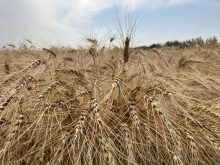Researchers have been putting wheat to the test in a Mexican desert to see if varieties with genes from wild relatives are better able to deal with hot conditions.
Scientists from the Earlham Institute in Norwich, England, and the International Maize and Wheat Improvement Centre in Mexico collaborated on the study. The latter, known as CIMMYT, has the largest maize and wheat gene bank in the world.
Most of the wheat grown around the world has limited genetic variation, said one of the study’s authors.
Read Also

Moo translator and methane measures: There’s an app for that
Dalhousie University researchers use artificial intelligence to create new dairy farm apps that analyze cattle sounds and measure methane.
“Wheat is responsible for around 20 per cent of the calories consumed globally and is widely grown all over the world,” said Anthony Hall of the Earlham Institute.
“But we don’t know whether the crops we’re planting today will be able to cope with tomorrow’s weather. To make matters worse, developing new varieties can take a decade or more, so acting quickly is vital.”
Researchers set up a two-year field trial in Mexico’s Sonora desert and studied 149 wheat lines. The varieties ranged from widely used elite lines to those selectively bred at the CIMMYT to include DNA from wild relatives and landraces from Mexico and India. The latter lines were drawn from the centre’s breeding and pre-breeding programs.
“Crossing elite lines with exotic material has its challenges,” said Matthew Reynolds, co-author of the study and leader of the wheat physiology program at the centre.
“There’s a well-recognized risk of bringing in more undesirable than desirable traits, so this result represents a significant breakthrough in overcoming that barrier and the continued utilization of genetic resources to boost climate resilience.”
The seeds were sown later in the season to force the plants to grow during hotter months, putting crops under the kind of heat stress that is predicted to become the norm.
They found the plants bred with exotic DNA achieved a 50 per cent higher yield over wheat without this DNA. The exotic lines didn’t perform any worse than the elite lines under normal conditions.
Researchers sequenced the plants to locate specific genetic differences responsible for increased heat tolerance. They identified genetic markers that could allow the targeted introduction of beneficial exotic DNA into elite lines, offering a quick way to improve climate resilience and mitigate against widespread crop failures.
“As we try to produce more food from less land to feed a growing global population, we urgently need to future-proof the crops we’re planting so they can thrive in an increasingly hostile climate,” said Benedict Coombes, study author and PhD student at the Earlham Institute.
“The key to this, we are increasingly finding, may lie within largely untapped genetic resources from wheat’s wild relatives and landraces.”
The researchers suggest breeding programs incorporate heat tolerance traits as a pre-emptive strategy to produce wheat crops that can cope with a less predictable climate.
“This is science we can now use to make an impact almost immediately,” added Hall. “We’ve done the field trials, we know what genetic markers we’re looking for, and we’re starting conversations with wheat breeders, so this is hopefully going to be the first of many steps to contribute to global food security in the coming years.
“The discoveries we’re making, and the action we’re taking, will hopefully mean people around the world can continue to have nutritious food on their plates.”















